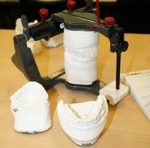The correct sequence to begin a full-mouth rehab is to
begin with the anterior teeth first, particularly the lower anterior teeth.
By: Dr. Leonard A. Hess, DDS
Clinical Director, The Dawson Academy
The Article Originally Appeared on TheDawsonAcademy.com
The question is, what would happen if one restored the posterior teeth first as many of us were counseled to do in dental school under the guise that if we did the anteriors first, many patients would not return to finish the posteriors?
This is not only short-sighted but wrong.
Stabilize the Occlusion First
I explained to the patient that the anterior teeth must be done first primarily due to function.
The interaction of the anterior teeth is critical in speech and phonetics. In addition, the esthetics of the case are determined by the height of both the maxillary and mandibular anterior teeth.
I like to prep and temporize the lower anteriors first, and establish the lower occlusal plane.

Then I will bring the patient back very soon and prep the upper anterior teeth, and establish the length and harmonize the anterior and lateral guidance in the temporaries.
At that appointment, I will also add resin to the posterior teeth on each side to establish stable holding contacts for the occlusion. This can be done with temporary crowns, or in many instances, by adding composite resin to the occlusal surfaces of the existing teeth and restorations.
The patient will leave with stable contacts on posterior teeth and accurate anterior temporaries, based upon the diagnostic wax-up. I will allow at least a week and up to a month to try out the new arrangement with revisions to the temporaries if necessary during that time.
What Determines the Border Movements of the TMJ?
The border movements of the TMJ are determined by the anatomy of the TMJ itself. Specifically, the condylar path is determined by the shape and form of the condyle/disc assembly and the muscle movements unique to each patient.
One must work within the condylar path and that is not determined by the posterior teeth. The posterior teeth must be shaped to stay out of the way of the condylar path.

Further, if one restored the posterior teeth first to a certain height, the anterior teeth might have to be too long for function, lip posture, and speech or too short for esthetics and function as well.
It is absolutely critical that the anterior guidance and the incisal edge position be established first.
You Need Properly Mounted Models and Diagnostic Photos
To execute a full mouth rehab, the first two critical steps are accurate models mounted in centric relation and proper diagnostic photos. From the photos, using the Dawson Diagnostic Wizard, one can determine a very close approximation of the height and width of the maxillary anterior teeth.

One can also estimate the height of the lower anterior teeth. The dentist can communicate to the dental lab the dimensions for the diagnostic wax-up. The wax-up also must include waxing the posteriors to the estimated height to establish the lower occlusal plane.
This is important before any preps are begun and also helps the patient understand that the entire case must be completed, even if it means doing in phases over time.
Now We Can Place the Temporaries
Once the anterior teeth are temporized and approved by the dentist and the patient, I will complete the lower anteriors first and cement them while the upper temporaries are in place.
Next, and often at the same visit, I will remove the upper temporaries, impress and send to the lab to cement the upper anteriors at the next visit.
When the anteriors are completed, depending on the patient preference and resources, I will complete the posteriors one quadrant at a time or one side at a time.
The posterior teeth have only one position to be as the vertical dimension has been established as well as the lateral and anterior guidance have been determined and verified in the temporaries. This is how the case can be phased if necessary by patient preference or constraints.
I Learned this Lesson the Hard Way
I learned this lesson the hard way when, before attending the Dawson Academy, I restored the posterior teeth first only to see the anterior teeth were not even close to the proper position for function or esthetics.
I was an part-time instructor at UK College of Dentistry at the time. I asked everyone in the Restorative department for help. I got various opinions but absolutely no concrete and concise plan of action to rectify this case. Finally, one professor suggested I see a local dentist in town who he assured me could help me.
I called this dentist (John Thompson DMD) and he was more than happy to help. Immediately, he asked for my mounted pre-op models and of course, I didn’t have any.
Any photos? Of course not.
I realized then there was a lot I didn’t learn in dental school or know about complex cases. He walked me through the case exactly as I have explained above and I re-did the treatment for no charge
Fortunately, it worked and has held up without any revisions for over 30 years now, I still see the same patient in my practice. I lost a lot of time and money but fortunately, the patient wasn’t upset as she had two failed attempts before me! We both were lucky!
In fact, she became a great referral source for many other patients as she loved the result and appreciated the time and effort for a great result.
Open your eyes to the possibilities of predictable dentistry in our foundational course, Core 1: Occlusion Smile Design


